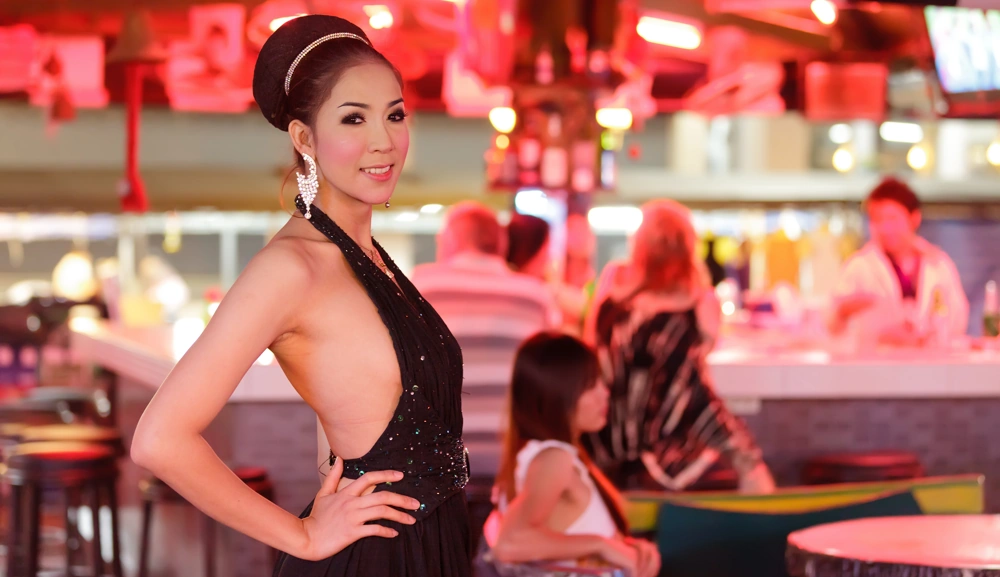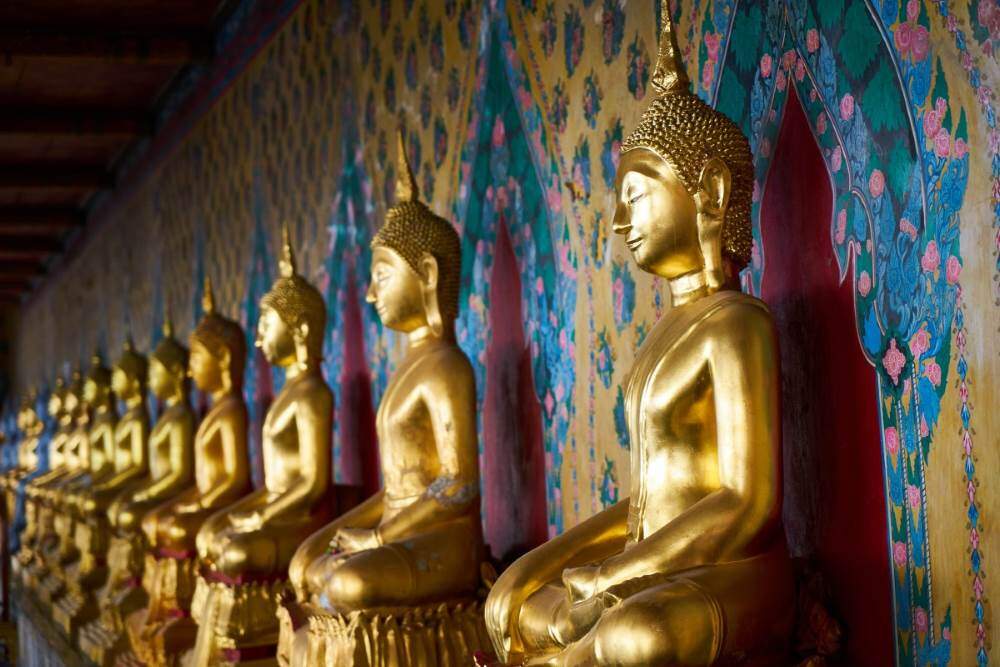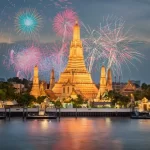In the vibrant landscape of Thailand, a peculiar phenomenon garners attention and intrigue - the ubiquitous presence of Kathoeys or 'Thai ladyboys'. This culturally unique group, often overlooked in mainstream discourses, offers rich insights into Thai society's acceptance of non-binary gender identities. While some societies struggle with binary norms, Thailand navigates smoothly through its cultural maze embracing a third gender.
A crucial factor steering this acceptance is Buddhism - Thailand's primary religion. The concept of Karma plays an influential role in understanding and accepting ladyboys as part of societal fabric rather than aberrations. However, a nuanced exploration reveals that their journey is not devoid of challenges; they negotiate complex terrains that oscillate between social marginalization and commercial objectification to artistic recognition.
This discourse illuminates how religious beliefs shape societal attitudes towards transgender people in Thailand, providing valuable perspectives on diversity and acceptance in Thai culture.
Key Takeaways
| Thai society's acceptance of ladyboys as a distinct third gender is influenced by religious beliefs, particularly those of Buddhism. |
| Ladyboys in Thailand face both societal acceptance and marginalization, with limited job opportunities and legal complications. |
| Beauty pageants like Miss Tiffany Universe symbolize the openness and pride with which many ladyboys live their lives in Thailand. |
| The future of ladyboys in Thai society is uncertain, but increased visibility of the LGBTQ+ community and changing socio-economic factors could lead to greater acceptance and opportunities for Kathoeys. |

Thailand: The Land of Ladyboys
In Thailand, a unique cultural phenomenon exists in the form of Kathoey or 'ladyboys', individuals who identify as a distinct third gender. Deeply ingrained in society, this phenomenon is heavily swayed by religious beliefs. Thai Buddhism, in particular, views transgenderism as an outcome of karma from past lives.
Consequently, an exploration into how societal attitudes and religious doctrines shape the experiences of ladyboys in Thailand unveils nuanced complexities concerning acceptance, identity formation, and socio-economic implications within this Southeast Asian context.
Understanding the Influence of Thai Society on Ladyboys
Thai society significantly shapes the experiences and identities of ladyboys, an intricate tapestry of cultural norms, religious beliefs, and societal expectations that gives rise to a unique understanding and acceptance of gender diversity.
- The Buddhist belief system prevalent among Thais suggests that being a Kathoey is the result of karma from past lives.
- This perspective shines a light on Thai society's impact on ladyboys. Often, Thai communities warmly accept them, owing to a spiritual understanding.
- The beauty of Kathoeys is widely lauded within these societies, and their effeminacy is viewed in a positive light.
- This viewpoint fosters an environment that embraces their unique gender identity.
This welcoming acceptance mirrors the compassionate ethos embedded in Thai Buddhism. Leading us into our next exploration: how this translates into the significance held by women and Ladyboys within Thai culture.
💡Read Next: Thai Ladyboy Dating: Meet Thai Ladyboys in Thailand
The Significance of Thai Women and Ladyboys in Thai Culture
In Thai society, there is an intricate interplay between gender roles and cultural norms, with a distinctive position occupied by women and Kathoeys or "ladyboys". The societal construct offers diverse roles to these individuals, which continue to evolve against the backdrop of traditional beliefs and modern influences.
An objective exploration into these roles provides profound insight into Thailand's unique social fabric where acceptance varies widely across different spectrums of the LGBTQ community.
The Role of Thai Women and Ladyboys
While Thai women often adopt a traditionally feminine role and ladyboys strive to embody exaggerated femininity, societal acceptance for both varies greatly, illustrating the complex relationship between gender roles and cultural norms in Thailand.
- The city of Pattaya is infamous for its nightlife, where many ladyboys find work due to limited opportunities elsewhere.
- Buddhism plays a pivotal part in shaping societal perspectives on transgenderism in Thailand; many believe being born Kathoey results from karmic consequences.
- Despite challenges, there are those who come to Thailand seeking acceptance or pursuing gender reassignment.
The role of Thai women and ladyboys undoubtedly contributes significantly to the rich tapestry of Thai culture. As we delve into 'Thai Law and Ladyboys: A Journey through Bangkok', we shall uncover more about their struggles for legal recognition.
Thai Law and Ladyboys: A Journey through Bangkok
Navigating the legal landscape presents unique challenges for Kathoeys, who strive to reconcile their identities with existing statutes. The intersection of Kathoey's existence and Thai law is a complex terrain marked by ambiguity, which reflects broader societal attitudes toward this distinct third gender. Examining this intersection provides critical insights into both the lived experiences of Kathoeys and the evolution of gender-related legislation in Thailand.
The Intersection of Kathoeys and Thai Law
Despite the cultural acceptance of Kathoeys or ladyboys in Thailand, their rights and recognition under the law remain limited and complex. The intersection of Kathoeys and law reveals discrepancies in how they are accepted socially, versus legally.
For instance, while gender transition surgeries such as Adams Apple reductions are prevalent, official documents often still reflect the birth gender which can lead to legal complications. This disparity affects areas such as employment; despite popular shows like 'Tiffanys' showcasing Kathoey's talent, broader job opportunities remain limited.
Yet, Thailand also demonstrates progress with ongoing debates on legally recognizing a third gender. As many Thai people continue to grapple with these issues, it paves the way for further discussion on ‘Kathoey: Thailand's Third Sex'.

Kathoey: Thailand's Third Sex
In Thai society, the Kathoey, or third gender, occupies a unique and complex social space. Although accepted to a certain extent due to Thailand's relatively tolerant attitudes towards transgenderism, their acceptance is nuanced and shaped by various socio-cultural factors such as religion, traditional gender roles, and societal expectations.
A deep examination of this subject provides an understanding of how cultural norms and belief systems influence perceptions of gender identity in Thailand.
The Perceptions and Acceptance of Kathoey in Society
Examining societal perceptions, the cultural acceptance of Kathoeys in Thailand emerges as an intriguing phenomenon. It's primarily shaped by religious beliefs and age-old norms. Numerous factors influence this social view and acceptance of Kathoeys. Transitioning smoothly, we'll further discuss these determinants.
- A common belief is that being a ladyboy is the result of misconduct in a previous life, thus aligning with karmic principles.
- Many Kathoeys find themselves marginalized due to these beliefs, often resorting to work within the nightlife sectors.
- Despite such challenges, many Ladyboys have managed to carve out successful careers beyond societal limitations.
- Facts about Thai ladyboys reveal they are recognized as a distinct third gender and not merely transvestites.
- Behind Kathoey's culture lies an undercurrent of resilience and determination amidst societal prejudice.
Navigating past these biases paints a more comprehensive picture beyond cabaret shows when exploring Ladyboys in Thailand.
💡Read Next: Unveiling The Secrets: How To Spot And Recognize Ladyboys In Thailand
Ladyboys in Thailand: Beyond the Cabaret Shows
In Thailand, the spectacle and celebration of transgenderism manifest prominently in cultural events such as Miss Tiffany Universe and other similar shows. These platforms provide an opportunity for Kathoeys to gain recognition and acceptance while showcasing their beauty, talent, and charisma in a society that often marginalizes them due to limited employment opportunities.
The study of these beauty pageants provides insightful perspectives into the complex societal dynamics surrounding Kathoey culture, underlining the intersectionality of gender, sexuality, tradition, religion, and modernity within society.
The Spectacle and Celebration: Miss Tiffany Universe and Other Shows in Thailand
Embracing the spirit of celebration and acceptance, Thailand is renowned for its grand showcases of Kathoey beauty and talent such as the Miss Tiffany Universe pageant. This spectacle has gained fame all over the world, symbolizing how many transgender individuals live their lives openly and proudly.
Thailand is also home to an increasing number of ladyboys who identify as women post-reassignment, demonstrating a significant evolution in Thai life perceptions towards third-gender individuals. Despite societal challenges, these grand events provide opportunities for Kathoeys to express their identities freely, reinforcing that they are not merely societal anomalies but integral parts of the culture.
As we delve deeper into this topic, it's essential to examine how Buddhism plays a pivotal role in shaping attitudes toward ladyboys.

The Role of Thai Buddhism in Understanding Ladyboys
The complex intersection between Buddhism in Thailand and the concept of transgenderism, particularly with regard to the Kathoey or 'ladyboy' culture, provides a unique lens for understanding societal acceptance in Thailand.
From the Buddhist teachings, we derive the perspective that perceives transgenderism not merely as a social or psychological phenomenon. Instead, it suggests that it's a karmic outcome of actions in previous lives. Hence, it provides a spiritual framework for understanding transgenderism.
Moreover, examining how these religious beliefs influence attitudes toward gender diversity in Thailand can offer profound insights into the nuanced dynamics between cultural norms, religious doctrine, and individual identity formation.
How Buddhism Helps to Understand the Concept of Transgender People
Delving into the intricate layers of Buddhism provides a unique lens to comprehend the concept and acceptance of transgender people, specifically Kathoeys, in Thailand. The religion posits four key principles that shed light on this:
- Many Buddhists believe Kathoeys choose to live as women due to karma from past lives.
- This transformation is seen by many tourists and locals alike as an intriguing aspect of Thai culture.
- Despite being biologically male, ladyboys become integral contributors to society but are often marginalized in their role within the reproductive process.
- Dressing as women is commonplace for Kathoeys, reflecting their self-acceptance despite societal constraints.
Thus, exploring how Buddhism helps to understand the concept of transgender people illuminates a complex interplay between religious beliefs and social acceptance. Next, we will delve into an understanding of karma's pivotal influence on Thai society.
The Concept of Karma and its Influence on Thai Society
The influence of Buddhism and the concept of karma permeates multiple aspects of society, including legal structures. The acceptance and understanding of the third gender or Kathoeys can be traced back to this very belief system, shaping societal attitudes and laws pertaining to this community.
This discussion will delve into an exploration of how Buddhism's teachings on karma have shaped perspectives towards transgenderism and consequently influenced law.
The Impact of Buddhism and Karma on Thai Law
Ironically, despite the spiritual undertones of karmic retribution that shape Thai society's view on transgenderism, legal recognition and protection for this third gender remain a hazy mirage in the desert of societal acceptance. The expected role in the reproductive cycle creates an ambiguous status for ladyboys within the framework of the law.
This is further compounded by Buddhist beliefs suggesting everyone has been Kathoey in previous lives due to karma's consequential nature. However, religious acceptance in Thailand does not automatically translate to legal inclusivity; this discrepancy attests to the complex relationship between Buddhism and state laws.
Furthermore, it raises questions about societal attitudes toward the growing number of transsexuals. These intricacies will be explored more deeply as we delve into 'transgender acceptance: the Thai perspective'.

Transgender Acceptance: The Thai Perspective
The intersection between Thai society and transgender individuals, particularly the Kathoey or 'ladyboys', provides a rich and complex landscape for understanding cultural acceptance of gender diversity. Rooted in religious beliefs, societal norms, and economic structures, Thailand's perspective on transgenderism offers intriguing contrasts; it acknowledges a distinct third gender while simultaneously attributing transgenderism to negative karma from past lives.
This dichotomy influences the lived experiences of these individuals extensively, impacting their career opportunities, personal relationships, and societal roles.
The Intersection of Thai Society and Transgender People
Understanding the unique intersection of Thai society and transgender people requires a deep dive into cultural, religious, and societal norms in Thailand. The acceptance of Kathoey largely contrasts the perspective of Westerners towards transgender individuals.
| Perspective | Thai Men | Gay Men |
|---|---|---|
| Societal Role | Fulfill an expected role | Less traditional roles |
| Viewed by Society | Often stigmatized | More accepted |
| Employment Opportunities | Limited sectors (e.g., nightlife) | Diverse careers |
Young Thais often find themselves navigating these complex identities and social expectations. Popular Thai belief suggests that a person is born as Kathoey due to past life karma. Thus, the intersection of Thai society and transgender people remains complex yet fascinating. As we move forward, let's delve into 'Beauty Shows in Thailand: The Dazzling World of Miss Tiffany Universe' showcasing another facet of this vibrant community.

Beauty Shows in Thailand: The Dazzling World of Miss Tiffany Universe
Delving into the world of beauty pageants in Thailand, one inevitably encounters the radiant spectacle of Miss Tiffany Universe. This celebrated event is more than a mere display of physical allure; it is an assertion of identity for many Kathoeys or 'ladyboys', offering a platform where they can fully embrace their femininity and challenge societal norms.
By exploring the behind-the-scenes intricacies of this pageant, we unveil not only its glamour and prestige but also its significant cultural implications within Thailand's diverse LGBTQ community.
Unmasking the Glamour: Behind the Scenes of Thailand's Most Celebrated Pageant
Behind the glitz and glamour of Thailand's most celebrated pageant, often dominated by Kathoey participants, lies a complex interplay between religious beliefs, societal acceptance, and personal identity. Unmasking the glamour reveals an intricate world where ladyboys and Buddhism intersect. Sukhumvit roads become stages for many to express their identities while exploring religious acceptance in Thailand.
The behind-the-scenes narratives of these pageants defy simplistic portrayals, pointing towards an escape from karmic debt as defined in Buddhist texts.
With compassion, we approach these individuals, though they often grapple with societal misconceptions. This dichotomy further entangles their lived experiences. As we transition deeper into this issue, our focus pivots to a sector fraught with misunderstanding - the Kathoeys, commonly seen in Thailand's nightlife scene, specifically within prostitution.
Kathoey in Thailand: Prostitution and Misunderstanding
Thailand's societal acceptance of Kathoeys, or ladyboys, represents a unique cultural lens through which gender identity is observed. However, this acceptance often treads a fine line with exploitation, particularly in relation to the nightlife sector and prevalent instances of prostitution among the Kathoey community.
This dichotomy underscores a complex interplay between cultural tolerance and socio-economic dynamics that necessitate further exploration for a comprehensive understanding of Thailand's place within a global discourse on gender diversity.
The Fine Line Between Acceptance and Exploitation in Thai Society
In the dynamic realm of Thai society, discerning between acceptance and exploitation of Kathoeys, commonly known as ladyboys, often proves elusive. Their presence, predominantly limited to nightlife and entertainment industries, reflects their constricted career opportunities.
Drawing parallels with a pregnant woman battling workplace discrimination, Kathoey encounters similar biases during job hunts. Struggling to secure their livelihoods, they navigate these trials without the assurance of medical assistance or societal approval.
It does not matter whether the man initially failed in caring for his expected gender role or chose this path willingly. What remains constant is their struggle to go about their daily tasks such as using public transport or securing stable income sources without facing bias. Whatever the reason behind their transition may be, it leads us into exploring 'the journey of kathoeys: from social outcasts to celebrated artists'.
The Journey of Kathoeys: From Social Outcasts to Celebrated Artists
The evolution of Kathoey, or ladyboys, from marginalized individuals to celebrated artists represents a unique facet of Thailand's socio-cultural landscape. This transformation underscores the fluidity and complexity of gender roles within Thai society, as well as the interplay between religious beliefs and societal acceptance.
An in-depth exploration into this journey not only sheds light on these individuals' pursuit for recognition but also contributes towards a nuanced understanding of Thailand's approach towards gender diversity and inclusivity.
Exploring the Transformation of Kathoey in Thailand
Understanding the transformation of Kathoey in Thailand requires a deep dive into both the societal and cultural structures that have allowed this unique third gender to emerge and evolve. The evolution has been shaped by various factors, including:
- The societal acceptance of Kathoey as a distinct gender unlike elsewhere in the world
- Buddhism's perspective on transgenderism as a result of misdeeds from past lives
- The frequent portrayal of Ladyboys in media and entertainment industries
- Economic constraints that push many Kathoey towards work in nightlife sectors
This intricate blend of religious, social, and economic factors has led to a complex yet fascinating journey for the Kathoeys. As we further delve into Buddhist principles, one can see how they've played an instrumental role in shaping this acceptance.

Buddhism's Role in the Acceptance of Thai Ladyboys
Buddhism's role in the recognition and acceptance of the third gender, particularly Thai ladyboys or Kathoeys, is a complex interplay between religious beliefs and societal norms.
Interpreting Buddhism as viewing transgenderism as a karma-driven consequence of past lives offers an intriguing perspective. This lens allows us to examine its wide acceptance. By delving into this relationship, we uncover vital insights. We see how religion molds societal attitudes toward gender diversity. As a result, it shapes Thailand's unique cultural mosaic.
Within this, Kathoeys are broadly embraced and integrated within their communities. All these insights highlight the importance of this perspective, which is exclusively articulated in the English language.
The Connection between Buddhists and the Widely Accepted Third Sex
Within the vibrant, diverse tapestry of Thai society, the acceptance of Kathoey, often referred to as 'ladyboys', flourishes. Much like a tree nurtured by the surrounding environment, this acceptance draws strength from the underlying tenets of Buddhism. Subtly, these principles hint that being transgender could stem from actions undertaken in a past life.
This religious understanding shapes society's perception and fosters tolerance for this third gender in various ways:
- Buddhism's interpretation of karma offers a moral framework justifying their existence.
- The spiritual belief in reincarnation provides an explanation for transgender identity.
- A compassionate Buddhist ethos encourages empathy towards ladyboys.
- The concept of impermanence reduces societal resistance to gender fluidity.
This religiously influenced acceptance has also permeated into other sectors such as dating, paving the way for our next exploration - 'Thai Ladyboy Dating in Thailand: Embracing Diversity'.
Thai Ladyboy Dating in Thailand: Embracing Diversity
As Thailand is renowned for its acceptance of the third gender, specifically Kathoeys or ladyboys, dating platforms such as MyLadyboyCupid have emerged to bridge the gap between love and acceptance.
Our platform presents an unprejudiced space that allows for diverse romantic opportunities amongst individuals who identify outside the conventional male-female binary. By focusing on this online dating site, one can analyze how such digital spaces are pivotal in promoting inclusivity and respect toward Ladyboys while simultaneously challenging societal norms and prejudices.
MyLadyboyCupid: A Platform Bridging Love and Acceptance
Fostering connections and providing a platform for love and acceptance, MyLadyboyCupid serves as a beacon of hope for Thailand's Kathoey community who often face employment barriers and societal stigma. As an online dating site, it caters specifically to transgender women and men seeking serious relationships.
| Benefits | Details |
|---|---|
| Community | Provides a safe space where members can connect with like-minded individuals |
| Identity Validation | Encourages self-love by validating members' identities |
| Opportunity | Offers potential partners who respect and value their transgender identity |
This platform not only aids in the formation of meaningful connections but also promotes the normalization of Kathoey within society. In turn, this fosters societal acceptance which is crucial to challenging prevailing prejudices. This discussion segues into the subsequent section that examines 'the role of Buddhism in shaping Thai society's views on transgender people'.
Conclusion: The Role of Buddhism in Shaping Thai Society's Views on Transgender People
The influence of Thai Buddhism on societal views towards transgender individuals, particularly Kathoey or 'ladyboys', is a significant dimension of Thailand's cultural narrative. This religious perspective, intertwined with notions of karma and reincarnation, has shaped public attitudes and acceptance levels toward this third-gender community.
As we delve into the future prospects for ladyboys within Thai society, it becomes essential to understand how these Buddhist principles could shape their trajectory in a rapidly evolving social landscape.
The Future of Thai Ladyboys in the Light of Thai Buddhism
Navigating the complex currents of societal acceptance and religious doctrine, Thailand's ladyboys face a future filled with uncertainty as they continue to grapple with the Buddhist belief in karma and reincarnation. While there is increased visibility of Kathoeys in popular culture, their status within Thai society remains largely marginal.
- The growth of the LGBTQ+ community and its increasing visibility may lead to greater acceptance and integration of ladyboys in Thai society.
- The changing socio-economic landscape could present more diverse career opportunities for Kathoeys outside the nightlife industry.
- Continued dialogue on transgender rights might influence legal changes that recognize and protect this third gender.
- A deeper understanding of Buddhism could help to reinterpret traditional beliefs on karma, possibly fostering a more inclusive attitude towards ladyboys.



